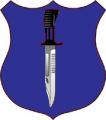I, too, recall seeing something about 3 M1s and 5 M3s, but I don't know where.
On page 153 of
http://www.cgsc.edu/carl/download/cs...scouts_out.pdf
it shows a ROAD divisional cavalry squadron platoon of 3 M551 Sheridans, 4 M114s and 2 M113 (I think, it simply says "APC" for the mortar section).
On page 167, it shows a L-series cavalry troop of 2 platoons of 4 M1s and 2 platoons of 4 M3s- I never tracked that organization, only the 2 platoons of 6 M3s, but I was never a heavy guy.
Figure 77, on page 264 of
http://www.cgsc.edu/carl/download/cs...eron_fight.pdf is a picture of a mixed M48/M114 platoon. On page 305-306, it describes tests of mixed M3/HMMWV platoons (6 HMMWV & 4 M3).
On page 319, it refers to a 3 M1/5 M3 platoon (in Europe, elswhere it was 2 M1/3 M3) as part of the transition of divisional cavalry squadrons from 2 pure M3 troops to the 3 mixed troops of 2 x 6 M3s and 2 x 4 M1s (as in the regimental squadrons).
On page 320, table 4 shows the different configurations of the Army scout platoons deployed in OPN Desert Storm. It addresses a 3 M1/5M3 platoon again on page 321, referencing Haworth's book, as an experimental design employed by one or two units (but not addressed in table 4).

















Bookmarks